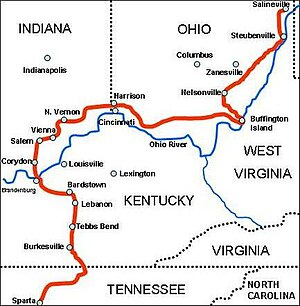Morgan's Raiders
| Morgan's Raid | |||||||
|---|---|---|---|---|---|---|---|
| Part of the American Civil War | |||||||
 Map of Morgan's route. Small groups of Morgan’s scouts and raiding parties rode through a number of southern Indiana counties. The main body of Morgan’s force followed a route through eight of those counties passing through such towns as Corydon, Salem, Lexington, Vernon (rather than North Vernon), and Versailles on the way to Harrison, Ohio. |
|||||||
|
|||||||
| Belligerents | |||||||
|
|
|
||||||
| Commanders and leaders | |||||||
|
Ambrose Burnside Henry M. Judah |
John Hunt Morgan | ||||||
| Strength | |||||||
| 40,000+ | 2,462 | ||||||
| Casualties and losses | |||||||
| 6,000 prisoners paroled | 2,000 prisoners taken | ||||||
Morgan's Raid was a highly publicized incursion by Confederate cavalry into the northern U.S. states of Indiana and Ohio during the American Civil War. The raid took place from June 11–July 26, 1863, and is named for the commander of the Confederates, Brig. Gen. John Hunt Morgan.
Morgan's Confederates during the 46 day raid covered more than 1,000 miles (1,600 km), beginning in Tennessee and ending in northern Ohio. Morgan's raid coincided with the Vicksburg Campaign and the Gettysburg Campaign, though it was not directly related to either. However, it was meant to draw away tens of thousands of U.S. troops away from these major campaigns and to frighten Northern civilians into demanding their troops be recalled to defend them. Despite his initial successes, Morgan was thwarted in his attempts to recross the Ohio River and eventually was forced to surrender what remained of his command in northeastern Ohio near the Pennsylvania border. Morgan and other senior officers were kept in the Ohio state penitentiary, but they tunneled their way out and casually took a train to Cincinnati, where they crossed the Ohio River to safety.
To many Confederates, the daring expedition behind enemy lines became known as The Great Raid of 1863, and was initially hailed in the newspapers. However, along with Gettysburg and Vicksburg, it was another in a string of defeats for the Confederate army that summer. Some Northern newspapers derisively labeled Morgan's expedition as The Calico Raid, in reference to the raiders' propensity for procuring personal goods from local stores and houses.
General Morgan and his 2,460 handpicked Confederate cavalrymen, along with 4 artillery pieces, departed from Sparta, Tennessee, on June 11, 1863, intending to divert the attention of the Union Army of the Ohio from Southern forces in the state and possibly stir up pro-southern sentiments in the North. Gen. Braxton Bragg, the regional Confederate commander, had intended for Morgan's cavalrymen to provide a distraction by entering Kentucky. Morgan, however, confided to some of his officers that he had long desired to invade Indiana and Ohio to bring the terror of war to the North. Bragg had given him carte blanche to ride throughout Tennessee and Kentucky, but ordered him to under no circumstances cross the Ohio River. On June 23, the Federal Army of the Cumberland began its operations against General Bragg's Confederate Army of Tennessee in what became known as the Tullahoma Campaign, and Morgan decided it was time to move northward into Kentucky.
...
Wikipedia
